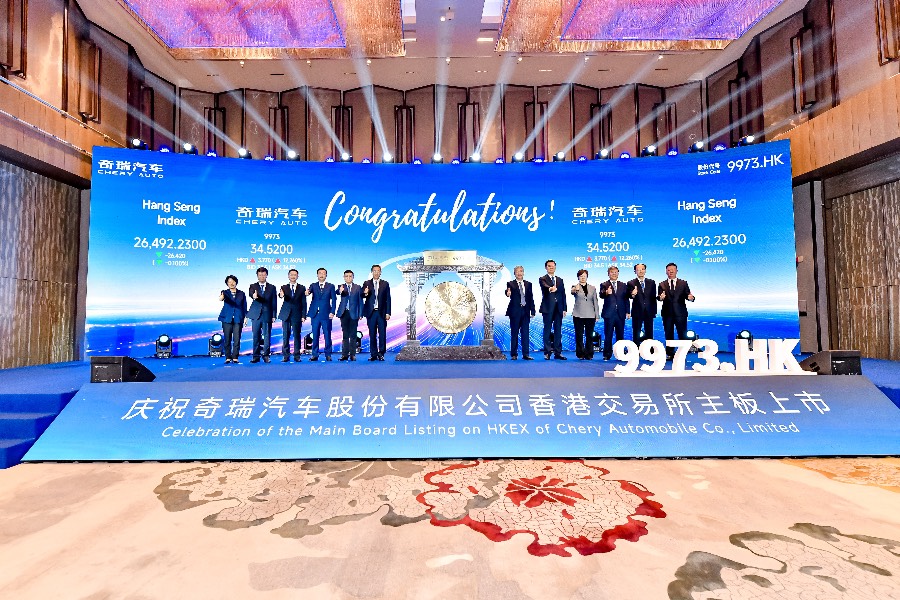Chery zooms out of the IPO gate. Now, it needs to show investors its longer-term value

China’s leading car export brand raised more than $1 billion in its listing on Sept. 25 , with its shares up 4% in their first three trading days
Key Takeaways:
- Chery’s stock has gotten off to a solid start since its IPO last week, with upside potential for its P/E multiple compared to its biggest domestic peers
- One of the car maker’s biggest challenges will be maintaining its rapid growth, which has made it China’s top exporting brand and the country’s sixth leading NEV seller this year
By Doug Young
First there was the euphoria as Chery Automobile Co. Ltd. (9973.HK) priced its IPO shares at the top of their range to raise more than $1 billion, becoming the world’s largest new listing by a carmaker this year. Now comes the hard part, as China’s leading domestic car exporter will need to keep showing long-term investors why it remains a solid bet in a crowded global car market where it competes with both international giants and hometown peers.
From a valuation perspective, investors already seem to be giving the company a relatively strong vote of confidence. But over the longer term, it will need to maintain its enviable growth that has been fueled in no small part by its exporting prowess. It will also need to show it can do that profitably, as its margins come under pressure in a saturated Chinese market plagued by overcapacity and stiff competition.
The company’s strong exports – which crossed a key critical threshold this year to make up more than half of its sales volume – has become a major factor behind its ability to continue posting strong double-digit growth and operating profitably. Chery was one of China’s earliest car makers to sell overseas, and has been its leading car exporter since 2003. But its hometown rivals are also aggressively courting overseas buyers, meaning competition will only get tougher outside their home market.
Chery’s shares made their Hong Kong trading debut on Sept. 25 with a 3.8% gain the first day, as it raised HK$9.15 billion ($1.18 billion) in gross proceeds in a listing that was heavily oversubscribed by both local and international investors.
Three days after the debut, the stock closed at HK$32.02, up 4.1% from the listing price of HK$30.75, giving Chery a market value of about $24 billion. By comparison, leading domestic car maker SAIC Motor (600104.SH) is similar sized with a market cap of about 194 billion yuan ($27 billion), while U.S. leader GM (GM.US) is more than twice that size at $58 billion.
But from a price-to-earnings (P/E) perspective, Chery still has valuation upside with a ratio of about 12, based on its 2024 profit when comparing with the 22 for the Hong Kong-listed shares of powerhouse BYD (1211.HK; 002594.SZ) and the 20 for Geely Auto(0175.HK), considered China’s two leading private carmakers.
Such a multiple shows the potential for upside to levels closer to its more highly valued peers, but it still means that Chery will need to maintain its fundamentals to prove its long-term potential. Any missteps could pressure that potential as it begins its new journey as a publicly traded company.
Export powerhouse
The latest data from the China Passenger Car Association (CPCA) shows that Chery was the fifth-largest car seller in China in the first eight months of this year. Its sales for the period rose 22% year-on-year to 860,126 vehicles – the second-fastest growth rate among the top 10 players, most of which reported growth below 12%.
The company’s namesake Chery brand accounted for about two-thirds of its parent’s 242,736 vehicles sold in August, while Jetour, its other major brand, made up about 22%, according to the monthly sales update on its WeChat account. Based in Eastern China’s Anhui province, the publicly listed Chery Auto contributes about 95% of the vehicle sales volume for its parent, Chery Group. The company’s other brands include Exeed, iCar and Luxeed.
Chery’s two biggest stories – and the biggest draw for investors – are its strength in exports and new energy vehicles (NEVs) that are two of the strongest growth areas for Chinese automakers.
The parent company’s exports rose 32.3% in August to a record monthly high of 129,472, as overseas sales edged past domestic sales to make up more than half of the 242,736 vehicles sold that month. To facilitate its overseas drive and hedge against future trade frictions, the company currently assembles vehicles outside China in Malaysia, and is building new joint venture facilities in Vietnam and Thailand.
The parent company’s NEV sales rose by an even bigger 53.1% in August from a year earlier to 71,218, accounting for 30% of its total sales volume for the month. Domestically, the company has zoomed ahead to become China’s sixth biggest NEV seller, with unit sales up 64% in the first eight months of this year to 309,025, according to the CPAC.
By comparison, NEV leader BYD was only able to muster 5.5% growth in China during the eight-month period, while Tesla’s sales actually fell 6.9%.
So, how does all of this translate to Chery’s major financial metrics? The company’s overall revenue rose 24% year-on-year in the first quarter of 2025 to 68.2 billion yuan, which is strong but marked a slowdown from 2024. Part of the slowdown owed to the price wars that have plagued China’s auto market for more than a year, dragging down prices for everyone. As that happened, Chery’s gross margin fell to 12.4% in the first quarter from 14.9% a year earlier.
The company more than offset the margin erosion through cost controls, most notably a 40% drop in administrative spending, while also keeping its R&D spending roughly flat. As a result, Chery’s profit nearly doubled to 4.73 billion yuan in the first quarter of this year from 2.48 billion yuan a year earlier, sharply accelerating from its 37% profit growth for all 2024.
But cost controls can only get you so far, and aren’t really a good formula for long-term success, especially for areas like R&D that require constant spending to stay ahead of the pack. That said, all of its rivals are also facing falling margins due to the current price wars. Beijing has taken a more aggressive stance towards easing such price wars in cars and other sectors this year, which could work to everyone’s advantage if those steps ultimately prove effective. In the meantime, Chery’s biggest edges will be its exporting prowess, and also the rapid growth of its NEV business both at home and abroad.
Bamboo Works offers a wide-ranging mix of coverage on U.S.- and Hong Kong-listed Chinese companies, including some sponsored content. For additional queries, including questions on individual articles, please contact us by clicking here
To subscribe to Bamboo Works free weekly newsletter, click here




